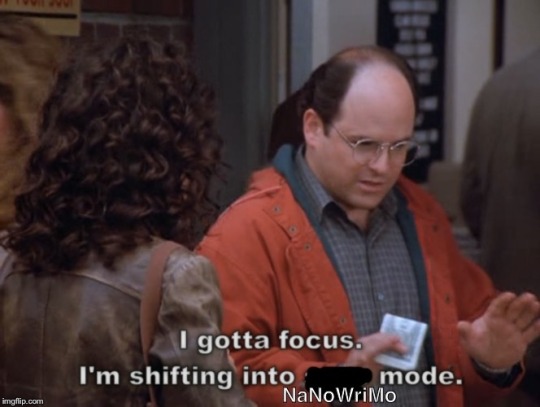Writer. INFJ. Ravenclaw. Capricorn. Rock opera enthusiast.
Don't wanna be here? Send us removal request.
Text
Some Top Tier Character Tropes:
Parroting someone’s catchphrase, motto, or mantra ironically back to them at a crucial moment for maximum angst.
Using incredible powers for mundane things or refusing to use them at all because they make things “boring”.
Bonus: using said powers for everything BUT what they were meant for.
Dramatically collapsing onto things, for drama because you’re spent, OR for comedy, because it’s always a good time to collapse dramatically.
Being too ignorant or jaded to react appropriately to danger.
Bonus: overreacts to ridiculously small threat OR everyone knows it’s going down if and only when this character finally acknowledges the threat.
Soft, mostly harmless bean pushed to the breaking point and unleashing everything they’ve been holding back.
2K notes
·
View notes
Text
Three-Act Structure in 30 Days
A Cog Special for NaNoWriMo
Hey friends! I’m unable to participate in NaNo this year, but! I thought I could share with you a “prompt list” I developed for myself. One prompt a day, this list might just help you achieve a complete book in 30 days! (Maybe.)
ACT ONE
11/01 - Develop what most inspires you. Let your world blossom, your character present themself, or your conflict begin.
11/02 - Introduce your protagonist’s day-to-day routine. Show who they are in their own element before their life spirals out of control.
11/03 - Show readers a conflict that’s been occupying your protagonist’s mind–use this as an opportunity to reveal another dimension of your world and the characters that inhabit it.
11/04 - Delve deeper into the side characters. Explore their superficial relationships with your protagonist.
11/05 - Bring in a new face. This face might belong to a new friend, a love interest, or even the villain.
11/06 - Take a moment to breathe, then destroy your protagonist’s world. Break it in such a way there’s no taping it back together. (And remember! This doesn’t have to be a bad change! Just an irreversible one.)
11/07 - Let your readers wallow in the fallout. Show how your protagonist initially responds and who they reach out to (if anyone).
Congratulations!! You’ve completed Act One! You’re well on your way to a book!! Remember to take a small breather and reward yourself. Look how much you’ve accomplished in as little as a week!
ACT TWO
11/08 - Your protagonist is on the precipice; let them jump. Encourage them. This is where the plot truly begins.
11/09 - Show your character the paths they can take. They don’t have to choose one yet, but let them know what their options are.
11/10 - Introduce conflict between your protagonist and one of the characters they thought they trusted.
11/11 - Explain away the conflict. Put your protagonist and that character back on somewhat firm ground–maybe there’s still suspicion, but it won’t break them. Yet.
11/12 - Make your character choose a path. It’s too late in the game to be all wishy-washy about what to do and how to do it.
11/13 - Show them that they’re not yet equipped to handle the primary conflict of your novel.
11/14 - Let them take a step back and re-asses. Let them consult with those that they trust and try to find how to best tackle the conflict.
11/15 - Give them a way to grow the skills they need or learn the information they need to best succeed in the main conflict.
11/16 - Renew their confidence. Little-by-little, help them remember that they can do this.
11/17 - Let your protagonist’s relationship with another character take an unexpected turn. This could be anything from them having helpful knowledge/skills to having a connection with the villain to being romantically interested in the protagonist.
11/18 - After all their hard work is paying off and your protagonist thinks they might just be able to succeed in their goal.
11/19 - The newfound skills/information/etc. your protagonist has gathered are put to the test, and they come out victorious. Delight all around!
Take a moment to think and reflect. Have a nice tea and prepare for everything to go utterly, terribly wrong, because that’s where we’re going with this.
11/20 - Your protagonist’s worst fear is confirmed and all the bravado they’ve gathered comes crashing down around them. (Hint: This is a great place to bring back the 11/10 conflict.)
11/21 - Your protagonist struggles to cope with the last blow they took, but they don’t have much time. They need to compose themself.
11/22 - Time to gear up for the grand finale. There’s no going back now, and everyone knows it. Let your protagonist and their allies gather.
Look at you go!! You’ve written the majority of a book?? You’ve made it through the hardest part and you’re in the home stretch. You can do it!!
ACT THREE
11/23 - Shove your protagonist into a room with the conflict that’s been haunting them from the beginning and let them have a moment with it.
11/24 - Bang! Pow! Climax time!
11/25 - Just when your protagonist thinks they’re winning, make it all go wrong. A fundamental piece of the puzzle is missing and we’re in disasterland now, lads.
11/26 - Let a side character prompt the protagonist’s defining moment–let them do something unexpected to prompt an even more unexpected response.
11/27 - Ideally, this will be victory time! Everything we’ve been hoping for since the beginning comes to fruition and all the protagonist’s hard work pays off. Alternatively, you could make this end real bad. It’s up to you.
11/28 - Let the results of the final conflict settle in. These could be good or bad, depending on your story, or even better: both.
11/29 - Go back to the beginning. Rewrite the first scene or develop a prologue. Now that you have a sense of the ending, you’ll have a better idea of where things should’ve started!
11/30 - Show your readers where everyone ended up–did they get a happy ending? A sad ending?
You’ve finished your book!!!!!!! YOU’VE FINISHED YOUR BOOK!!! Heck yeah.
3K notes
·
View notes
Note
hey do you have any tips on plot development? how to do come up with relevant but dramatic things to keep the plot going? i also don’t want to make it too intense?
I actually have quite a lot of resources that I’ve created over the years surrounding plot development. I’ve linked as many as I could find for you:
Resources For Plot Development
Useful Writing Resources
Useful Writing Resources II
31 Days of Plot Development
Novel Planning 101
How To Write A Good Plot Twist
How To Foreshadow
What To Cut Out Of Your Story
Tackling Subplots
Things A Reader Needs From A Story
A Guide To Tension & Suspense In Your Writing
How To Turn A Good Idea Into A Good Story
Planning A Scene In A Story
21 Plot Shapes and the Pros and Cons Of Each
How To Outline Effectively
Tips On Writing Intense Scenes
Writing The First Chapter
Tips On Starting A Scene
Plot Structures
Finding & Fixing Plot Holes
17K notes
·
View notes
Text
how to make a story file
As I am preparing for Camp NaNo*, I have been working on my story file. It occurred to me this might not be common or popular practice. “Story File” is a name I gave it and maybe some of y’all have a different name with the same contents.
*There’s still time to apply to join my Camp NaNo cabin!
My Story File contains everything about my story that doesn’t go in the outline.
It’s broken up into major categories and specific templates. So without further ado, here is how I structure my Story File.
Intro
Title
Logline
Synopsis
Genre
Estimated Total Length (word count)
Draft Length Goal (word count)
Character Bank
Main characters and brief, one-sentence descriptions with ages
Themes and Character Development
Central Question
The Yes/No question that is being asked through the whole story
Should have objective qualities, rather than subjective
i.e. “Will they fall in love?” (subjective) vs. “Will they leave their partners and become a couple?” (objective)
Thematic Questions
These are the internal conflict questions that reside in your character(s) and your story
ex. “Can there really be a successful government?”
ex. “Does grief excuse bad actions?”
Themes at a Glance
Words or phrases that relate to the themes of the story
ex. person vs. nature
ex. isolation
ex. grief
ex. first love
Motivation / Stasis State / Final State
for each main character, you should write a sentence or two pertaining to these three things
Motivation: What is the drive behind this character and their past, present, and future actions? What part of their background makes them the way that they are? What are they looking for? What do they want out of this/a situation?
Stasis State: What are they like before the inciting incident? What problems and questions do they have?
Final State: What has changed about them and their outlook? What questions have they resolved? What has happened to their internal conflict?
Relationships
I usually make a little web of the MCs and their relationship to one another. One for the stasis and one for final.
Stasis: How do these characters see each other? How do they act toward the other? (All before the inciting incident)
Final: How do these characters see each other now? How has their idea of one another shifted?
Even if a character dies before the end, include the most recent relationship status in the Final web.
ex. this is how I organize it, using the Draw feature of Google Docs

Character Bank
This is just a very preliminary character bank. If you prefer a more in-depth one, check out my 6 Box Method.
Per (relevant/important) character:
Name
Nickname/preferred name
Age
Field/Occupation
Physical Description
Personality
Personal History
Education/Occupation History
Extra Notes:
Worldbuilding Bank
(Check out my worldbuilding posts on Categories Pt. 1 and 2 for better context)
Seasons and Climate
Languages
Other Cultural Pockets
Folklore and Legends
Fine Arts
Dress and Modesty
Classes
Jobs
Currency and Economics
Shopping
Agriculture and Livestock
Imports and Exports
Literature, Pop Culture, and Entertainment
Food and Water
Holidays and Festivals
Family and Parenting
Relationships
Housing
Religion and Beliefs
Government
Health and Medicine
Technology and Communication
Death
Transportation
Plants, Animals, and Human-environment Interaction
Education
Beauty Standards
Gender and Sexuality
—————————
I hope this helps y’all and supplements what you’re probably already doing. I know it’s helped me tons to have everything in a central place.
Best of luck!
6K notes
·
View notes
Text
how to write like tolkein:
take everything that scares you. everything that angers you. everything you care about and value and want to protect.
use the things you're passionate about to bind them together
pour your heart and soul into a story, even if your heart and soul are wounded
(especially if they're wounded, one might argue, because although trauma isn't necessary to tell a story, emotional honesty is)
be unafraid to capture everything that matters to you, even if it's something as small as quaint country traditions
use your past, your present — use what you know and what you've lived — and turn it into fuel
remember that ordinary people will always be interesting enough to carry a story
because at the end of the day, Tolkein's success wasn't due to elves and ents and dragons
but because he used all he had seen in his time at war, all the things he loved about peace, all the stories and myths he was passionate about, and poured them into his work
he told the story he needed to tell, based on the things that were important to him
his trauma. his interests. his passions. his dreams. his grief.
he took the stories that had been told a thousand times before in a thousand versions and added something nobody else could:
his voice
and that is ultimately what makes a story great
398 notes
·
View notes
Text
Autumn makes me want to live in a small town with tons of history and character. Leaf-strewn cobblestone streets. Old buildings and homes that range from small cottages to large estates. Maple, oak, and pine trees line the streets and cluster in yards, and when they all turn orange and gold in the fall it’s the most beautiful sight. Small local businesses thrive. It’s walking distance to your favorite coffee shop or diner. There’s an ancient library on the edge of town with the greatest selection of books, comfy armchairs, tables, and big windows to read by. Time moves slower there. Everything is safe.
25K notes
·
View notes
Text
What Scenes to Cut
If you’re finished with your first draft, you might be wondering how to cut down an overloaded novel. Chances are your novel isn’t exactly where you want it to be and you might need to trim the fat, so take the time to learn what should and should not be included in your story.
Here are a few ways to determine what should be cut from your novel:
First, let’s talk about filler. Filler is unnecessary information added to your novel that does nothing to tell us about your characters or advance the plot. In other words, your book shouldn’t have any filler. Your book’s momentum will be ruined if you add filler.
Does the scene explain your character in some way?
If a scene is necessary to character development, there’s usually no reason to cut it. However, if a scene doesn’t help build a character or doesn’t explain anything additional about your character, you should consider cutting it. There’s no need to repeat the same information over and over again. Consider combining scenes that spread the same message.
Does the scene move the plot forward?
Obviously your story needs to keep pushing forward. We need to see the plot advance and it needs to make logical sense. If the scene doesn’t move the plot forward, nor does it help reveal something about character, it should most likely be cut. Each scene should build on the one before it and should add something significant to your story.
Is your scene necessary for transition to the next scene?
Since you can’t just cut abruptly from one scene to another, you’ll need transitions in your novel. Even though they might not contribute to character development directly, it gets your characters from one place to another. If a scene bridges the gap between one important moment to another, you shouldn’t cut it.
Do all my characters play a part?
Sometimes certain minor characters can either be cut or combined with other minor characters. I’m not saying you shouldn’t have characters that play a small part, but they should at least play some part in your story. It can be hard to cut characters, but sometimes it’s necessary to make your story stronger. Anything that you feel will strengthen your novel and cut down the excess is something you should pay attention to.
Don’t be afraid to cut sub plots that aren’t working.
If there’s a part of your story that just doesn’t feel like it’s working out or doesn’t jive with your story, don’t be afraid to cut it. You can always replace it with something stronger, so don’t feel like anything you cut is a loss. You’ll be able to make your story more powerful.
-Kris Noel
5K notes
·
View notes
Text
my biggest flaw is that i plan out these big, elaborate WIPs and when it gets down to actually writing i realize i have absolutely no idea how to write it.
799 notes
·
View notes
Text
“Years ago a friend of mine had a dream about a strange invention; a staircase you could descend deep underground, in which you heard recordings of all the things anyone had ever said about you, both good and bad. The catch was, you had to pass through all the worst things people had said before you could get to the highest compliments at the very bottom. There is no way I would ever make it more than two and a half steps down such a staircase, but I understand its terrible logic: if we want the rewards of being loved we have to submit to the mortifying ordeal of being known.”
— I Know What You Think of Me, Tim Kreider for the New York Times
188K notes
·
View notes
Text
I think people who criticize “meaningless fluff,” “pointless angst,” and other similar styles of fan-writings, have forgotten about something called aestheticism. Art for art’s sake. Not every piece of art or writing must have some deeper meaning. Some things exist to be merely be observed or felt- not to teach a lesson or do what some think “real” literature should.
So if you’re writing a 50K coffee shop!AU with nothing but fun shenanigans and fluff, don’t let anyone tell you it’s meaningless or pointless. The point of it is for it to be enjoyed and observed as it is. It doesn’t have to have some deep and poignant societal/political undertone or lesson for it to be a worthy piece of literature.
A lot of popular authors have created writings which can be categorized as art for art’s sake and have contributed to aestheticism. So you are in good company.
33K notes
·
View notes
Text
huwwo if you post about your wip/are a writeblr pls reblog this!!
354 notes
·
View notes
Text
i am SO SICK of unhappy endings. idk about anyone else but the #1 reason i like fiction is because everything can always work out no matter how bad it is. “what if the good guys lost” shut up. you are so fucking boring. give me happy endings or give me nothing
185K notes
·
View notes
Photo
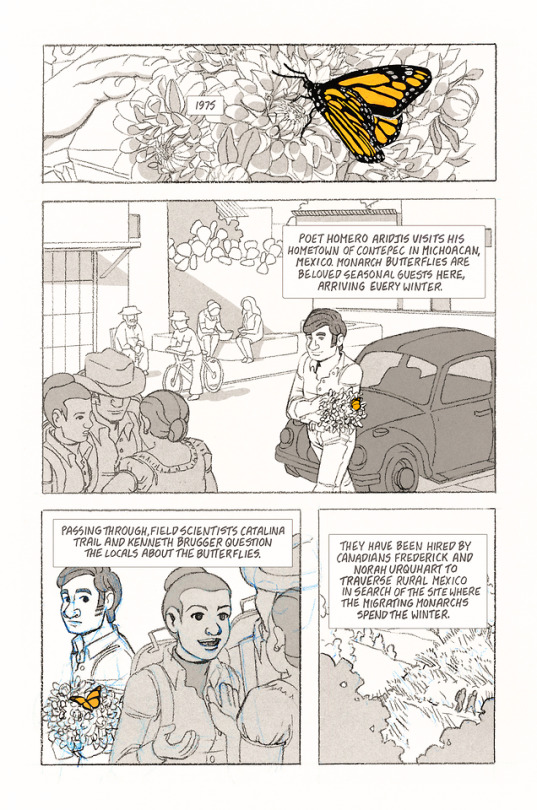
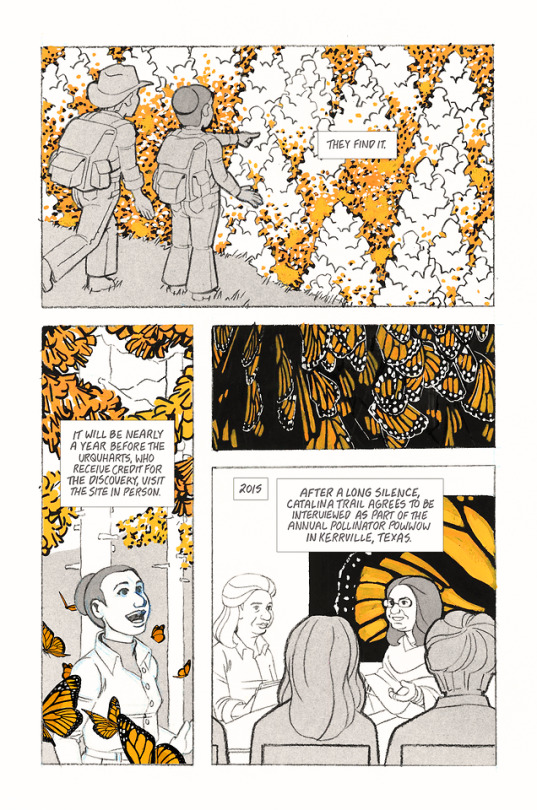
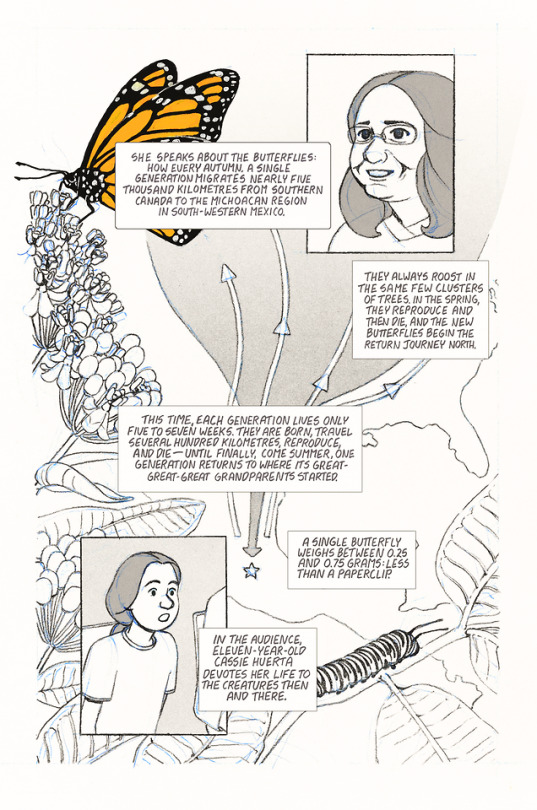
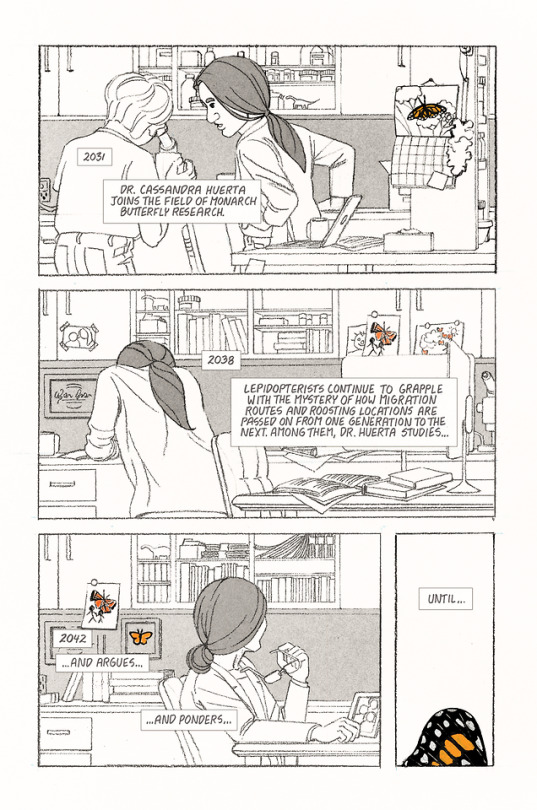
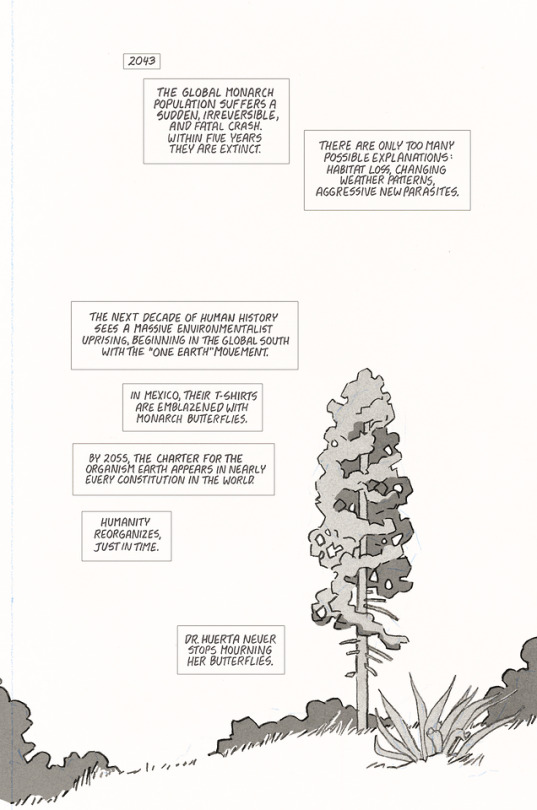

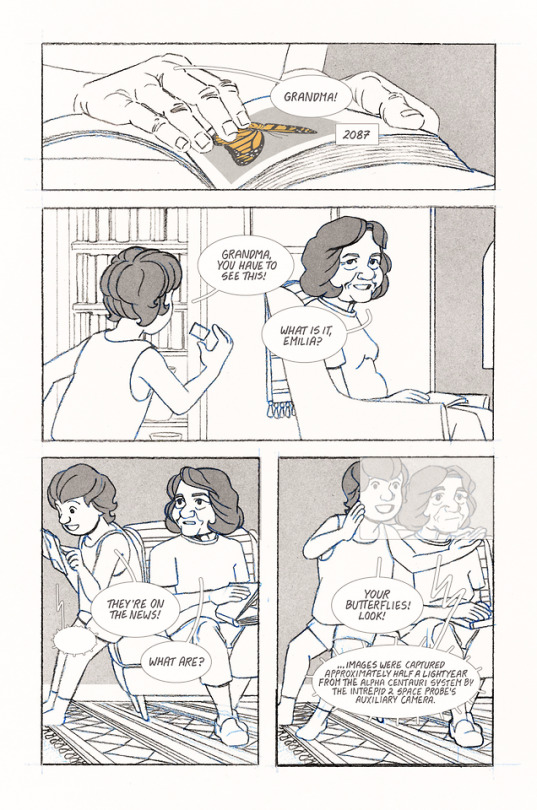
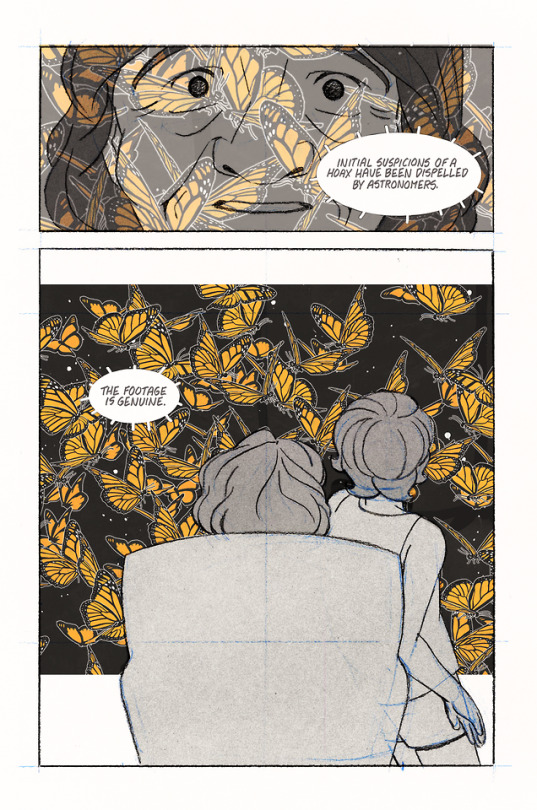
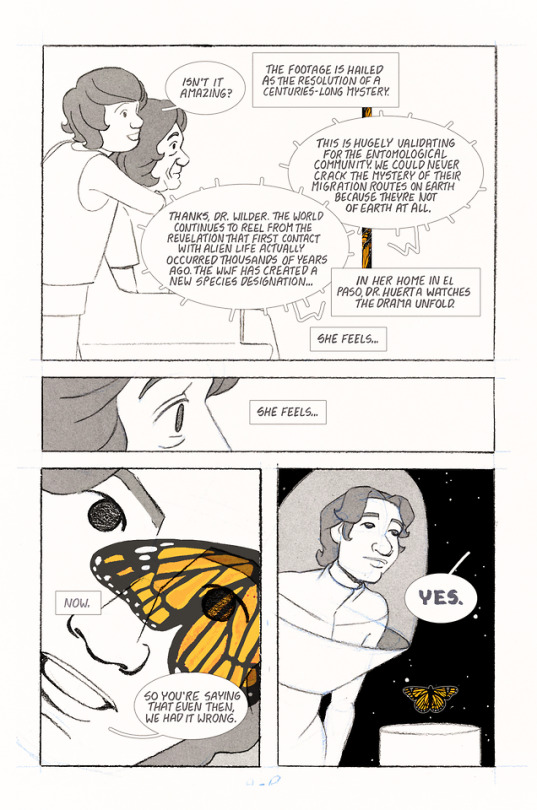
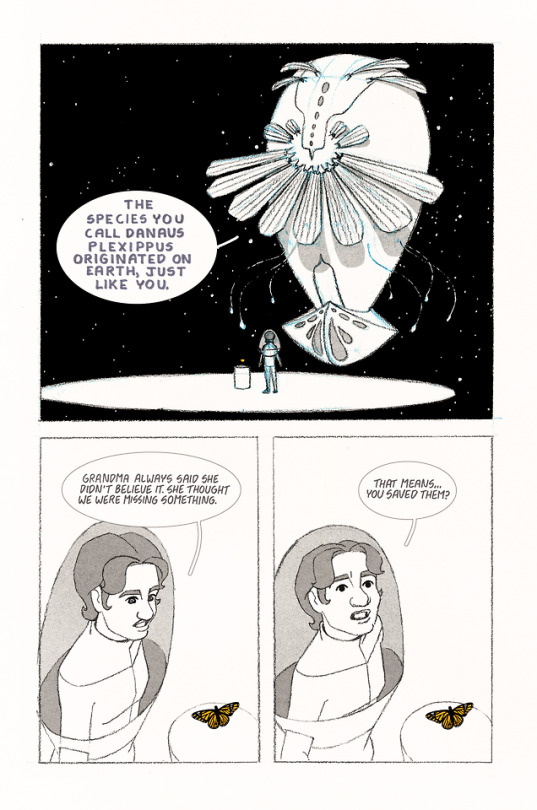
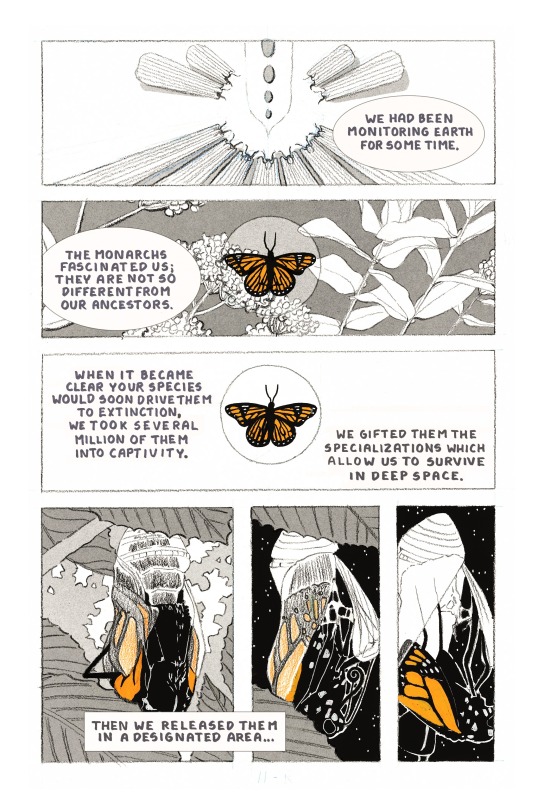
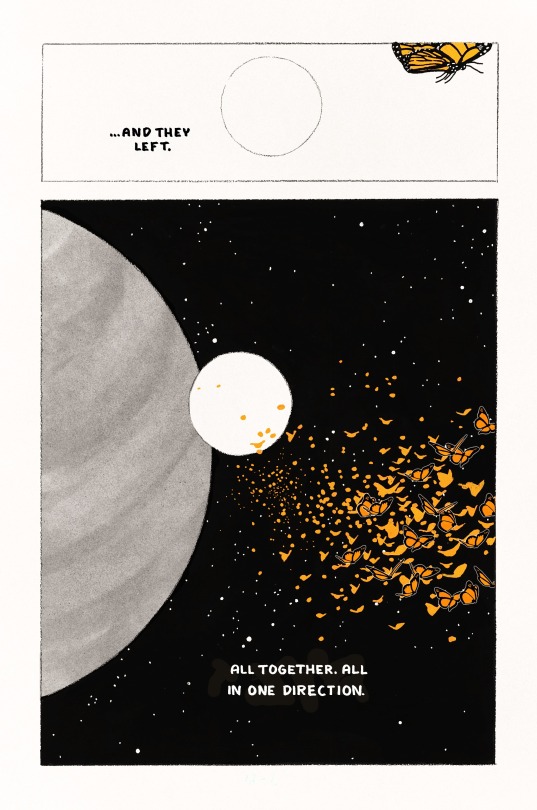

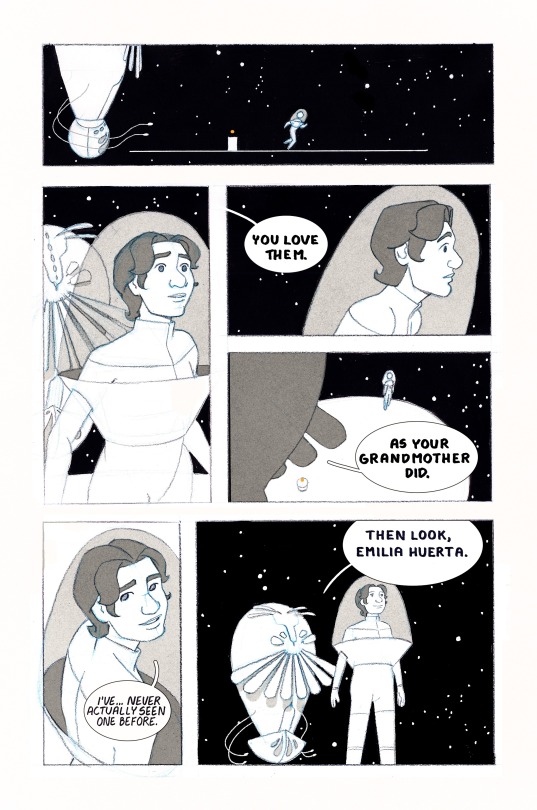
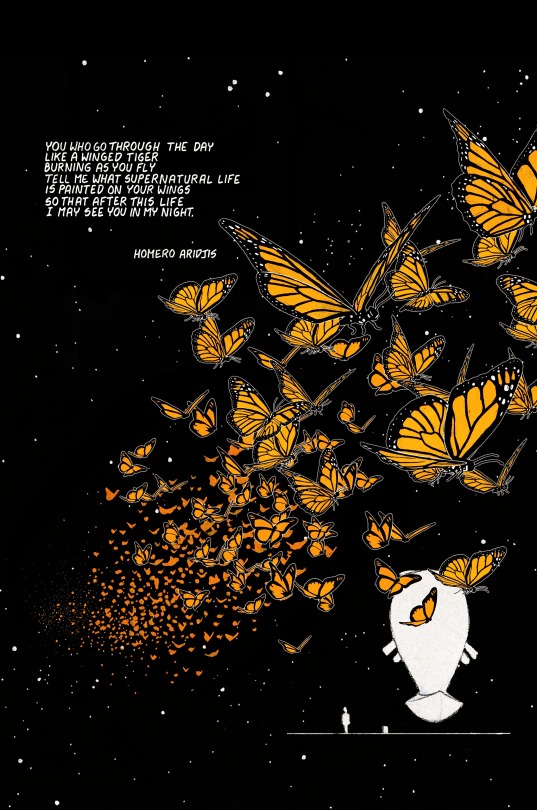
OPENING INTO WINGS (2019)
A comic about generational journeys, the search for knowledge and the many ways it can go wrong, and the grace of accepting ignorance.
15K notes
·
View notes
Text
T I P S Y : SPLITE for Worldbuilding
Hello, everyone! ^^ I’m back with a special Tipsy this Tuesday. I want to share this nifty little table I used to use back in high school for my AP World History course. Whenever we analyzed a civilization, we would use a SPRITE table. SPRITE stands for Social, Political, Religious, Intellectual/Ideological, Technological, and Economic.
I’ve changed this so that it’s a SPLITE table (so it’s now Social, Political, Locational, Intellectual/Ideological, Technological, and Economic). The reason that I replaced the Religious with the Locational is because I felt it made more sense from a worldbuilding point of view to put more emphasis on geography and location. I wanted to present a really basic, essential look at creating fantasy worlds, and location really plays a big role in what it takes to build a world. A fantasy world can be built without religious considerations, but it cannot be built without locational considerations. A story has to take place somewhere, after all, and usually that somewhere has huge bearings on the story itself.
So, before I start rambling on about details, here’s the poster that I created for you to be able to download and use! ^^ (Tumblr reduces quality, so when you click on it you’ll find that it’s actually really high quality, so go on ahead and right-click, download, and use it to your heart’s content!) (For a PDF version, scroll down to the bottom of the post.)
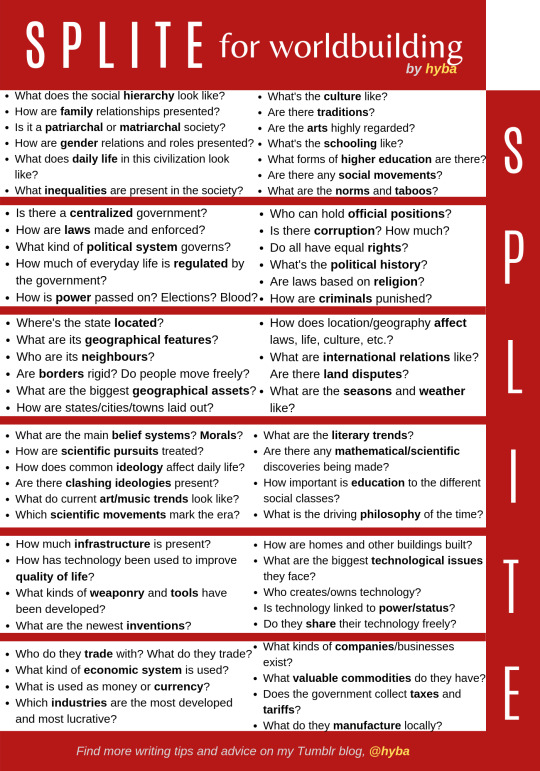
Those are a lot of questions! I squeezed as many as I could in the boxes. Can you tell? ^^’ It’s a bit crowded.
As an overall look at worldbuilding, this should be a good guide to help you get the civilizations in your worlds ready for those discerning readers of yours who’ll want to know more!
But there’s more! Keep reading ^^
Keep reading
1K notes
·
View notes











